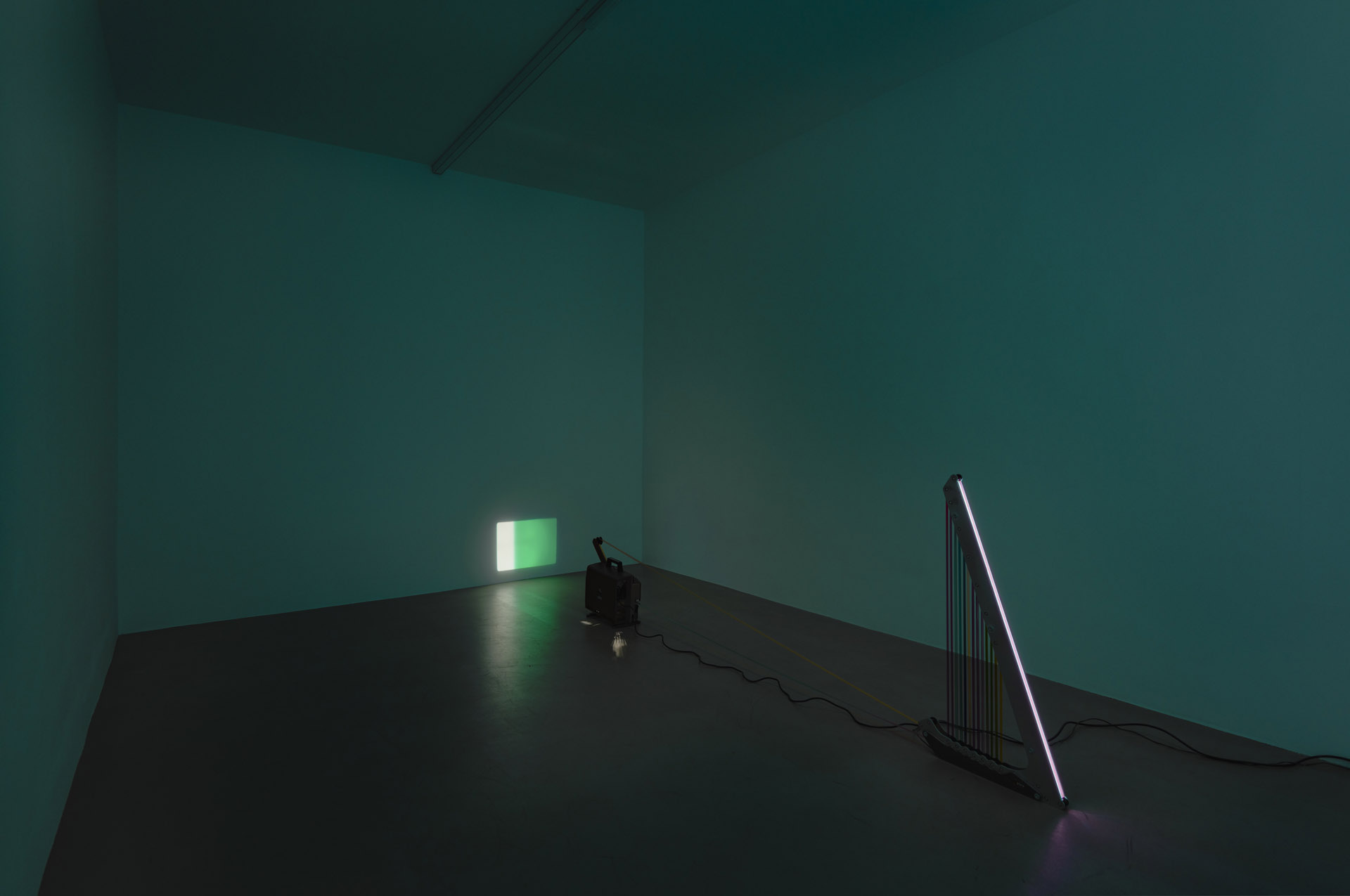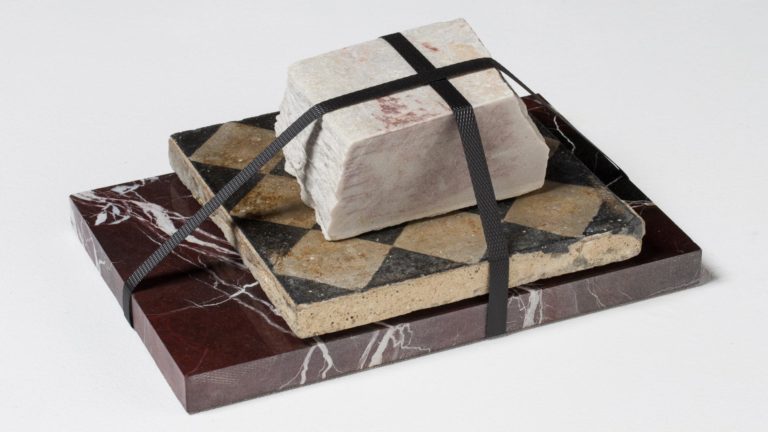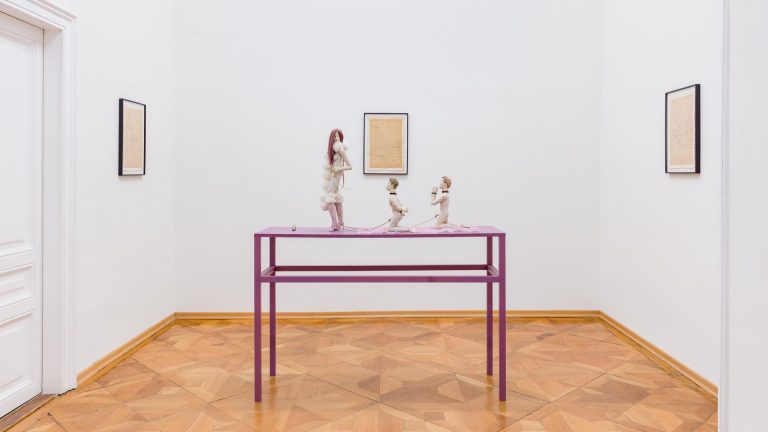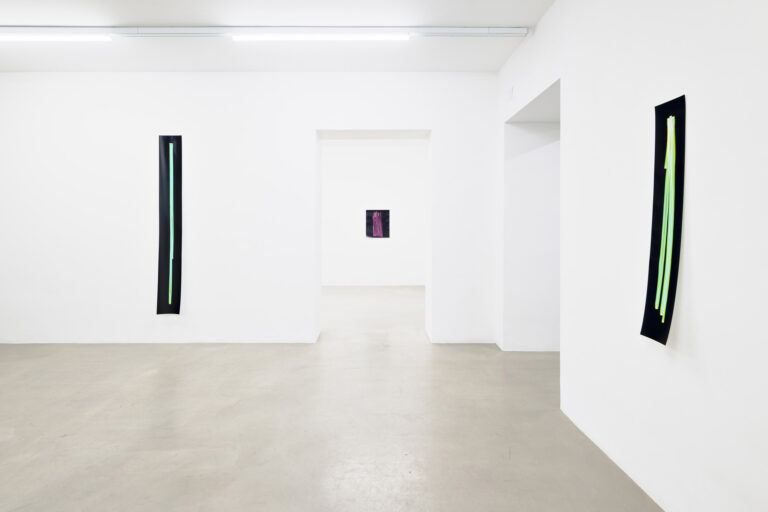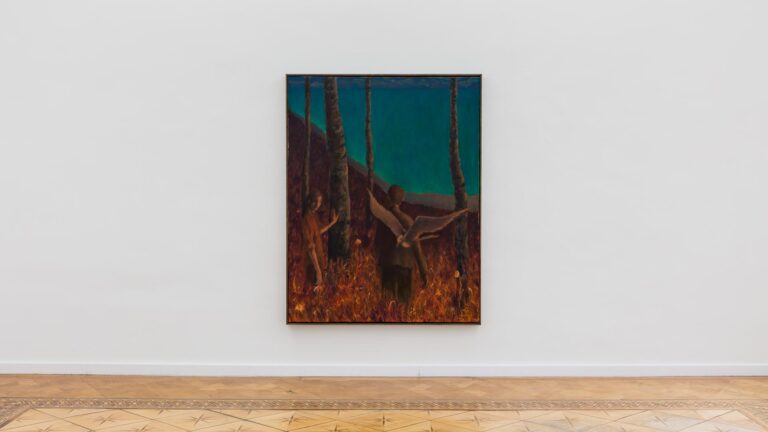Artist: Philipp Fleischmann
Exhibition title: Two Film Sculptures
Venue: Wonnerth Dejaco, Vienna, Austria
Date: January 13 – February 26, 2022
Photography: Peter Mochi / all images copyright and courtesy of the artist and Wonnerth Dejaco, Vienna
Following the line: Philipp Fleischmann’s Film Sculptures
“The artist might also investigate by way of lines I’ll call ‘organic,’ lines that function as doors, as connections among materials, as tissues, etc., in order to modulate an entire surface.”1 Brazilian artist Lygia Clark first explained her concept of the “organic line” in 1956. It does not manifest itself as an artistically generated abstract form, but rather unfolds in the moment of the encounter, for example, between image and frame; it is at once an interstice or void and a seam or parenthesis. Clark’s “organic lines” have their origins in architectural space and in the materiality of textiles.
Similar to the way in which Clark’s “organic lines” confront painting, Philipp Fleischmann’s Film Sculptures approach film: as a living medium anchored in material reality. In his new works, the artist arranges the 16mm film strip in loops by means of a specially designed looper visually resembling a harp and lets it run over a narrow lightbox, only a few centimeters in width. Placed on the gallery floor, the projector throws images of abstract forms onto the wall. The line (of the film strip) meets the rectangle (of the filmic image) in the space of the exhibition.
Fleischmann’s 16mm films were made in the studio by means of direct exposure of the filmstrip, quite in keeping with traditions of historical avant-garde film, so-called camera-less “direct cinema” experiments – such as those of Stan Brakhage in the 1960s – that intervened in the material quality of film. Whereas films of this kind were projected onto the screen in the same way as classical cinema, the “expanded cinema” works of the 1970s took the entire cinematic dispositif into consideration as an entanglement of body and technology, material and image, production and projection. In this context, Anthony McCall’s work Line Describing a Cone (1973), for example, dedicated itself to film as a temporal-sculptural medium, in which the light beam of the 16mm projector drew a circle on the wall and, at the same time, a cone in the smoke-filled room over the course of half an hour.
Philipp Fleischmann’s Film Sculptures, however, distance themselves from those attempts to dissolve the boundaries of the cinematic medium. In his works, the artist argues neither for nor against medium specificity. Rather, Fleischmann sketches a topology of film that manifests itself spatially as the expansion and multiplication of the filmic material in the film strip as it is guided in loops through the sculptural display. Similar to Lygia Clark’s “organic line,” this material simultaneously produces voids and interstices where real space appears as negative space between the vertical lamellae of the Film Sculptures. The film strip moves as a material line, inherent to the medium, between the twofold sources of light and image, the projection surface and the lightbox, respectively. In their intense chromaticity, the projected images and the illuminated film strip appear as the end poles of a movement in space. In reality, though, this movement is endless. Not the film frame as an illusion of reality, but the film strip as a line of material liveliness.
-Bettina Brunner
(Translated from German)
1 Lygia Clark, conference in Belo Horizonte (1956), quoted in: Luis Peréz-Oramas, Part 2: Lygia Clark: If You Hold a Stone (2018), https://post.moma.org/part-2-lygia-clark-if-you-hold-a-stone/
Two Film Sculptures, Philipp Fleischmann, installation view, Wonnerth Dejaco, Vienna 2022. © Wonnerth Dejaco and the artist. Photo: Peter Mochi
Two Film Sculptures, Philipp Fleischmann, installation view, Wonnerth Dejaco, Vienna 2022. © Wonnerth Dejaco and the artist. Photo: Peter Mochi
Philipp Fleischmann, Film Sculpture (1), 2022, 16mm film, color, silent, aluminium, polyoxymethylene, 100 × 20 × 296 cm. © Wonnerth Dejaco and the artist 2022. Photo: Peter Mochi
Philipp Fleischmann, Film Sculpture (1), 2022, 16mm film, color, silent, aluminium, polyoxymethylene, 100 × 20 × 296 cm. © Wonnerth Dejaco and the artist 2022. Photo: Peter Mochi
Philipp Fleischmann, Film Sculpture (1), 2022 (detail), 16mm film, color, silent, aluminium, polyoxymethylene, 100 × 20 × 296 cm. © Wonnerth Dejaco and the artist 2022. Photo: Peter Mochi
Philipp Fleischmann, Film Sculpture (1), 2022 (detail), 16mm film, color, silent, aluminium, polyoxymethylene, 100 × 20 × 296 cm. © Wonnerth Dejaco and the artist 2022. Photo: Peter Mochi
Philipp Fleischmann, Film Sculpture (1), 2022 (detail), 16mm film, color, silent, aluminium, polyoxymethylene, 100 × 20 × 296 cm. © Wonnerth Dejaco and the artist 2022. Photo: Peter Mochi
Philipp Fleischmann, Film Sculpture (1), 2022, 16mm film, color, silent, aluminium, polyoxymethylene, 100 × 20 × 296 cm. © Wonnerth Dejaco and the artist 2022. Photo: Peter Mochi
Philipp Fleischmann, Film Sculpture (1), 2022 (detail), 16mm film, color, silent, aluminium, polyoxymethylene, 100 × 20 × 296 cm. © Wonnerth Dejaco and the artist 2022. Photo: Peter Mochi
Philipp Fleischmann, Film Sculpture (2), 2022, 16mm film, color, silent, aluminium, polyoxymethylene, 154 × 20 × 150 cm. © Wonnerth Dejaco and the artist 2022. Photo: Peter Mochi
Philipp Fleischmann, Film Sculpture (2), 2022, 16mm film, color, silent, aluminium, polyoxymethylene, 154 × 20 × 150 cm. © Wonnerth Dejaco and the artist 2022. Photo: Peter Mochi
Two Film Sculptures, Philipp Fleischmann, installation view, Wonnerth Dejaco, Vienna 2022. © Wonnerth Dejaco and the artist. Photo: Peter Mochi




